Workplace Wellbeing and Employee Retention: A Strategic Report
VerifiedAdded on 2023/05/28
|10
|2779
|378
Report
AI Summary
This report delves into the significance of workplace wellbeing, encompassing aspects from workplace safety to employee satisfaction, and its crucial role in employee retention and organizational effectiveness. It identifies key stakeholders, including employers, employees, and unions, and underscores the importance of their involvement in promoting a healthy work environment. The research methodology employs both primary methods like employee satisfaction surveys and interviews, and secondary methods such as government reports and HRIS data, to analyze factors affecting employee wellbeing. Findings reveal that issues like stress and anxiety significantly impact productivity, highlighting the need for proactive management interventions. The report also examines the financial implications of employee ill-health and the potential cost benefits of wellness initiatives. Furthermore, it discusses approaches to improve employee wellbeing, including policy adoption, communication enhancement, and the use of HR software solutions. The conclusion emphasizes the importance of creating a supportive environment and recognizing employee contributions, while the recommendation advocates for customized feedback and the use of HR software to ensure proper employee record management.
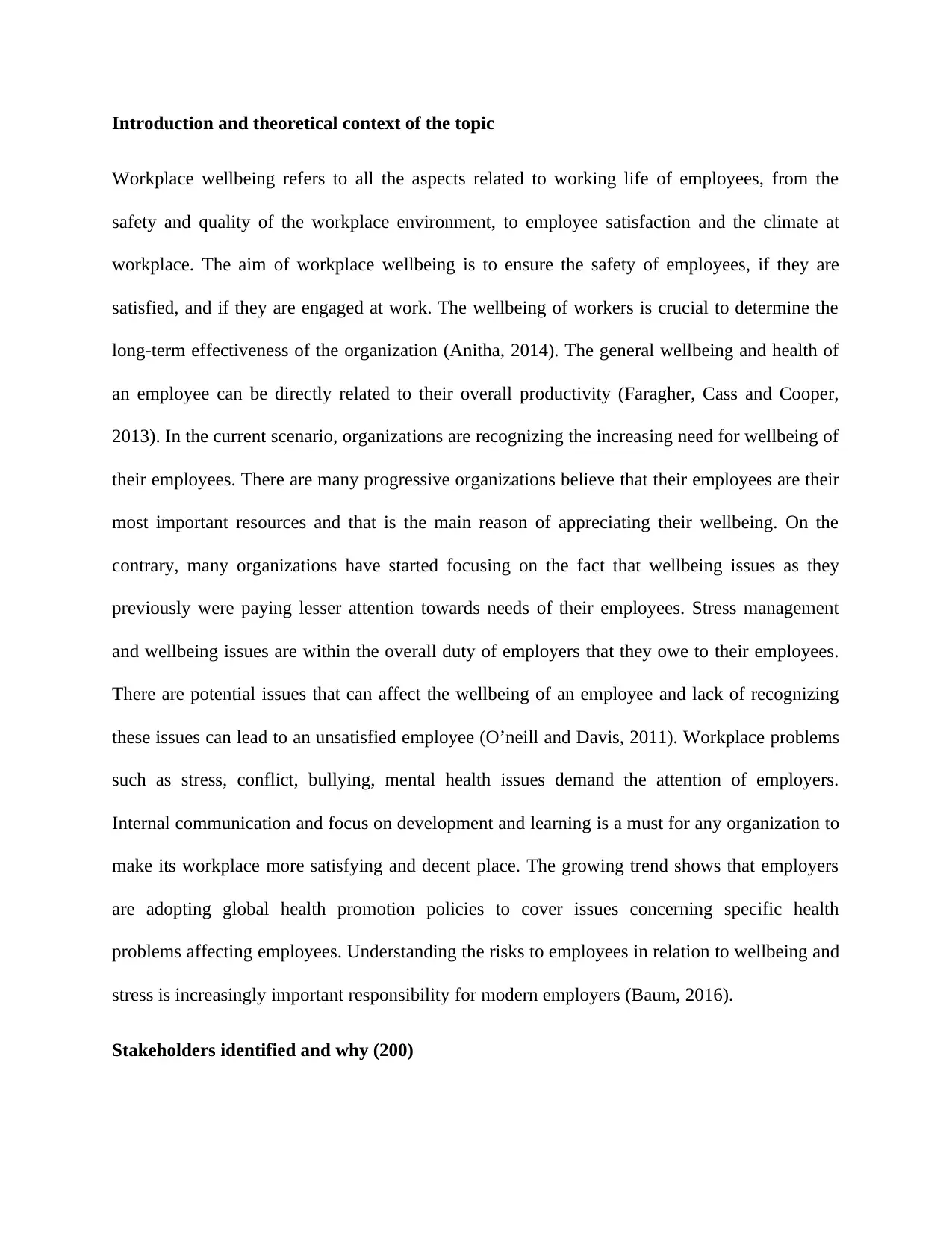
Introduction and theoretical context of the topic
Workplace wellbeing refers to all the aspects related to working life of employees, from the
safety and quality of the workplace environment, to employee satisfaction and the climate at
workplace. The aim of workplace wellbeing is to ensure the safety of employees, if they are
satisfied, and if they are engaged at work. The wellbeing of workers is crucial to determine the
long-term effectiveness of the organization (Anitha, 2014). The general wellbeing and health of
an employee can be directly related to their overall productivity (Faragher, Cass and Cooper,
2013). In the current scenario, organizations are recognizing the increasing need for wellbeing of
their employees. There are many progressive organizations believe that their employees are their
most important resources and that is the main reason of appreciating their wellbeing. On the
contrary, many organizations have started focusing on the fact that wellbeing issues as they
previously were paying lesser attention towards needs of their employees. Stress management
and wellbeing issues are within the overall duty of employers that they owe to their employees.
There are potential issues that can affect the wellbeing of an employee and lack of recognizing
these issues can lead to an unsatisfied employee (O’neill and Davis, 2011). Workplace problems
such as stress, conflict, bullying, mental health issues demand the attention of employers.
Internal communication and focus on development and learning is a must for any organization to
make its workplace more satisfying and decent place. The growing trend shows that employers
are adopting global health promotion policies to cover issues concerning specific health
problems affecting employees. Understanding the risks to employees in relation to wellbeing and
stress is increasingly important responsibility for modern employers (Baum, 2016).
Stakeholders identified and why (200)
Workplace wellbeing refers to all the aspects related to working life of employees, from the
safety and quality of the workplace environment, to employee satisfaction and the climate at
workplace. The aim of workplace wellbeing is to ensure the safety of employees, if they are
satisfied, and if they are engaged at work. The wellbeing of workers is crucial to determine the
long-term effectiveness of the organization (Anitha, 2014). The general wellbeing and health of
an employee can be directly related to their overall productivity (Faragher, Cass and Cooper,
2013). In the current scenario, organizations are recognizing the increasing need for wellbeing of
their employees. There are many progressive organizations believe that their employees are their
most important resources and that is the main reason of appreciating their wellbeing. On the
contrary, many organizations have started focusing on the fact that wellbeing issues as they
previously were paying lesser attention towards needs of their employees. Stress management
and wellbeing issues are within the overall duty of employers that they owe to their employees.
There are potential issues that can affect the wellbeing of an employee and lack of recognizing
these issues can lead to an unsatisfied employee (O’neill and Davis, 2011). Workplace problems
such as stress, conflict, bullying, mental health issues demand the attention of employers.
Internal communication and focus on development and learning is a must for any organization to
make its workplace more satisfying and decent place. The growing trend shows that employers
are adopting global health promotion policies to cover issues concerning specific health
problems affecting employees. Understanding the risks to employees in relation to wellbeing and
stress is increasingly important responsibility for modern employers (Baum, 2016).
Stakeholders identified and why (200)
Paraphrase This Document
Need a fresh take? Get an instant paraphrase of this document with our AI Paraphraser
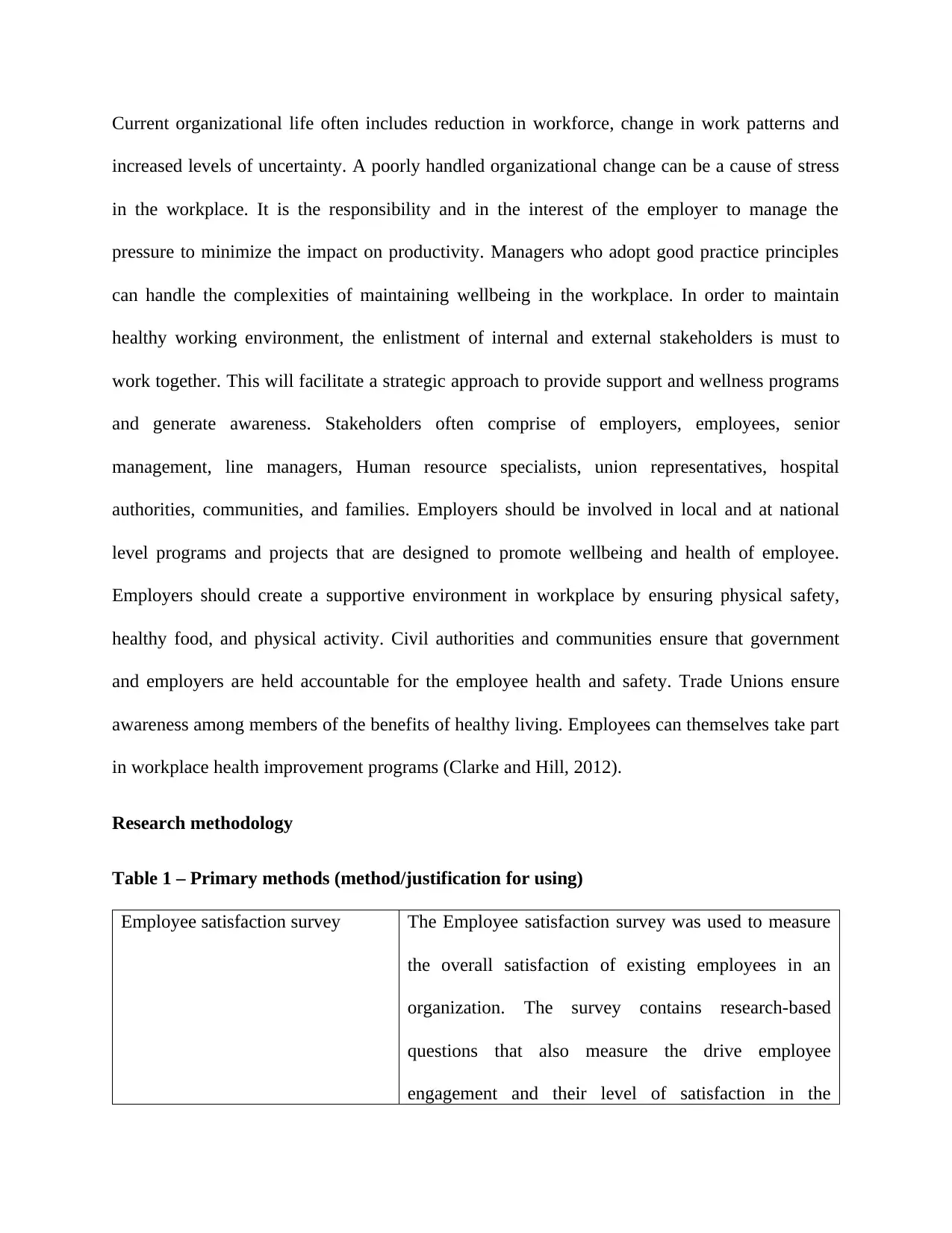
Current organizational life often includes reduction in workforce, change in work patterns and
increased levels of uncertainty. A poorly handled organizational change can be a cause of stress
in the workplace. It is the responsibility and in the interest of the employer to manage the
pressure to minimize the impact on productivity. Managers who adopt good practice principles
can handle the complexities of maintaining wellbeing in the workplace. In order to maintain
healthy working environment, the enlistment of internal and external stakeholders is must to
work together. This will facilitate a strategic approach to provide support and wellness programs
and generate awareness. Stakeholders often comprise of employers, employees, senior
management, line managers, Human resource specialists, union representatives, hospital
authorities, communities, and families. Employers should be involved in local and at national
level programs and projects that are designed to promote wellbeing and health of employee.
Employers should create a supportive environment in workplace by ensuring physical safety,
healthy food, and physical activity. Civil authorities and communities ensure that government
and employers are held accountable for the employee health and safety. Trade Unions ensure
awareness among members of the benefits of healthy living. Employees can themselves take part
in workplace health improvement programs (Clarke and Hill, 2012).
Research methodology
Table 1 – Primary methods (method/justification for using)
Employee satisfaction survey The Employee satisfaction survey was used to measure
the overall satisfaction of existing employees in an
organization. The survey contains research-based
questions that also measure the drive employee
engagement and their level of satisfaction in the
increased levels of uncertainty. A poorly handled organizational change can be a cause of stress
in the workplace. It is the responsibility and in the interest of the employer to manage the
pressure to minimize the impact on productivity. Managers who adopt good practice principles
can handle the complexities of maintaining wellbeing in the workplace. In order to maintain
healthy working environment, the enlistment of internal and external stakeholders is must to
work together. This will facilitate a strategic approach to provide support and wellness programs
and generate awareness. Stakeholders often comprise of employers, employees, senior
management, line managers, Human resource specialists, union representatives, hospital
authorities, communities, and families. Employers should be involved in local and at national
level programs and projects that are designed to promote wellbeing and health of employee.
Employers should create a supportive environment in workplace by ensuring physical safety,
healthy food, and physical activity. Civil authorities and communities ensure that government
and employers are held accountable for the employee health and safety. Trade Unions ensure
awareness among members of the benefits of healthy living. Employees can themselves take part
in workplace health improvement programs (Clarke and Hill, 2012).
Research methodology
Table 1 – Primary methods (method/justification for using)
Employee satisfaction survey The Employee satisfaction survey was used to measure
the overall satisfaction of existing employees in an
organization. The survey contains research-based
questions that also measure the drive employee
engagement and their level of satisfaction in the

organization. The questions contain open-ended
questions to know employee responses.
Interviews with Employees and
Lower management
The interview conducted with the employees were face-
to-face conversations on their workplace environment,
safety and health measures taken, promotional activities
on health benefits, measures taken to retain employees
and improve overall productivity of employees.
Table 2 – Secondary methods (method/justification for using)
In order to complete the research following secondary data were used.
Local Government UK Health &
Wellness Report
The data gathered from the report provides the brief on
current workplace conditions and health of employees
with focus on case studies and evidence-based work.
The focus lies on employed individuals with poor health
conditions at workplace
HRIS Report The Human Resources Information System helps to
understand the employee turnover rate through turnover
reports. It will help ascertaining the factors that may be
causing employee turnover.
Sales and Financial Reports (2016
vs 2017)
The comparison between the 2016 and 2017 reports
state that employees are more concerned about their
questions to know employee responses.
Interviews with Employees and
Lower management
The interview conducted with the employees were face-
to-face conversations on their workplace environment,
safety and health measures taken, promotional activities
on health benefits, measures taken to retain employees
and improve overall productivity of employees.
Table 2 – Secondary methods (method/justification for using)
In order to complete the research following secondary data were used.
Local Government UK Health &
Wellness Report
The data gathered from the report provides the brief on
current workplace conditions and health of employees
with focus on case studies and evidence-based work.
The focus lies on employed individuals with poor health
conditions at workplace
HRIS Report The Human Resources Information System helps to
understand the employee turnover rate through turnover
reports. It will help ascertaining the factors that may be
causing employee turnover.
Sales and Financial Reports (2016
vs 2017)
The comparison between the 2016 and 2017 reports
state that employees are more concerned about their
⊘ This is a preview!⊘
Do you want full access?
Subscribe today to unlock all pages.

Trusted by 1+ million students worldwide
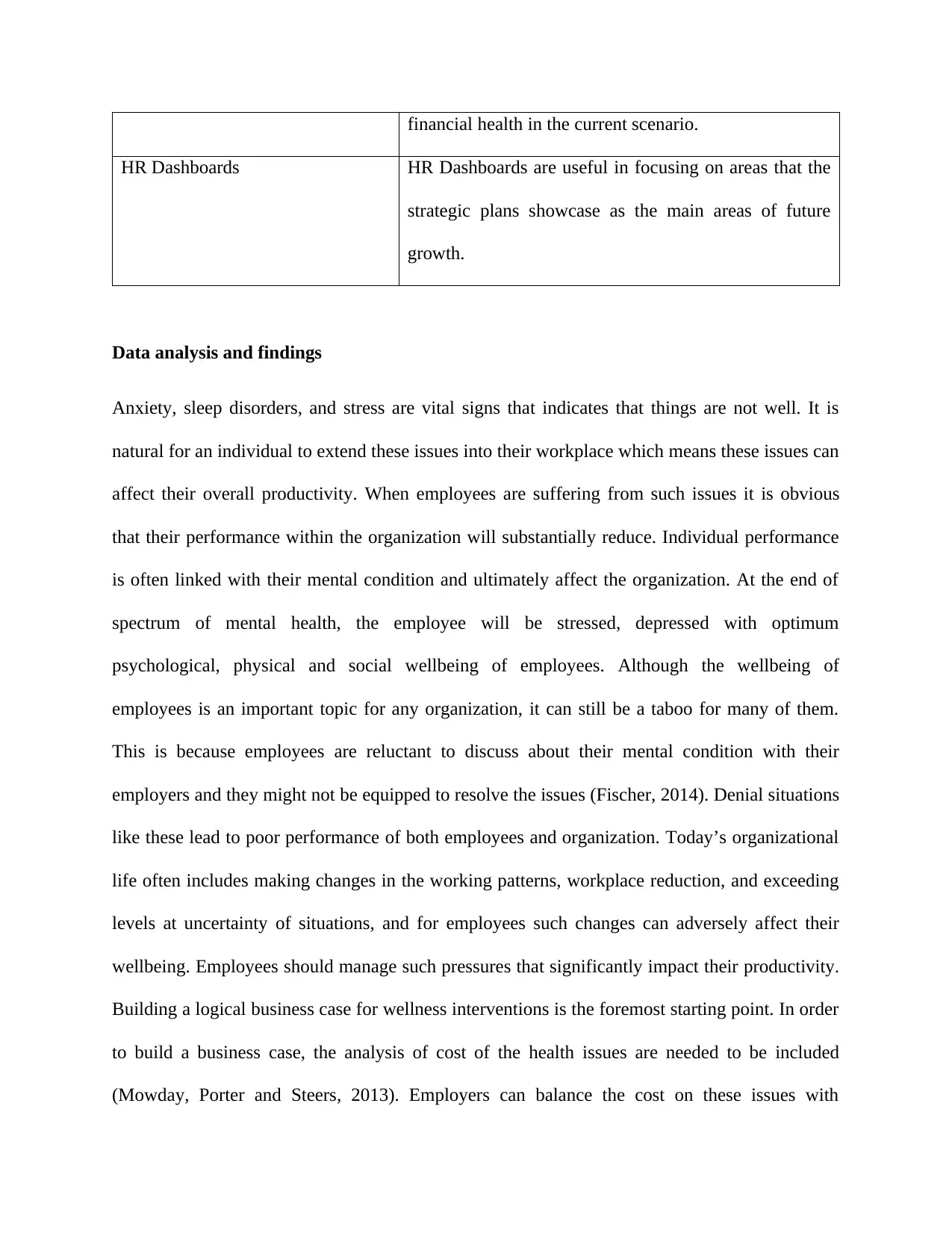
financial health in the current scenario.
HR Dashboards HR Dashboards are useful in focusing on areas that the
strategic plans showcase as the main areas of future
growth.
Data analysis and findings
Anxiety, sleep disorders, and stress are vital signs that indicates that things are not well. It is
natural for an individual to extend these issues into their workplace which means these issues can
affect their overall productivity. When employees are suffering from such issues it is obvious
that their performance within the organization will substantially reduce. Individual performance
is often linked with their mental condition and ultimately affect the organization. At the end of
spectrum of mental health, the employee will be stressed, depressed with optimum
psychological, physical and social wellbeing of employees. Although the wellbeing of
employees is an important topic for any organization, it can still be a taboo for many of them.
This is because employees are reluctant to discuss about their mental condition with their
employers and they might not be equipped to resolve the issues (Fischer, 2014). Denial situations
like these lead to poor performance of both employees and organization. Today’s organizational
life often includes making changes in the working patterns, workplace reduction, and exceeding
levels at uncertainty of situations, and for employees such changes can adversely affect their
wellbeing. Employees should manage such pressures that significantly impact their productivity.
Building a logical business case for wellness interventions is the foremost starting point. In order
to build a business case, the analysis of cost of the health issues are needed to be included
(Mowday, Porter and Steers, 2013). Employers can balance the cost on these issues with
HR Dashboards HR Dashboards are useful in focusing on areas that the
strategic plans showcase as the main areas of future
growth.
Data analysis and findings
Anxiety, sleep disorders, and stress are vital signs that indicates that things are not well. It is
natural for an individual to extend these issues into their workplace which means these issues can
affect their overall productivity. When employees are suffering from such issues it is obvious
that their performance within the organization will substantially reduce. Individual performance
is often linked with their mental condition and ultimately affect the organization. At the end of
spectrum of mental health, the employee will be stressed, depressed with optimum
psychological, physical and social wellbeing of employees. Although the wellbeing of
employees is an important topic for any organization, it can still be a taboo for many of them.
This is because employees are reluctant to discuss about their mental condition with their
employers and they might not be equipped to resolve the issues (Fischer, 2014). Denial situations
like these lead to poor performance of both employees and organization. Today’s organizational
life often includes making changes in the working patterns, workplace reduction, and exceeding
levels at uncertainty of situations, and for employees such changes can adversely affect their
wellbeing. Employees should manage such pressures that significantly impact their productivity.
Building a logical business case for wellness interventions is the foremost starting point. In order
to build a business case, the analysis of cost of the health issues are needed to be included
(Mowday, Porter and Steers, 2013). Employers can balance the cost on these issues with
Paraphrase This Document
Need a fresh take? Get an instant paraphrase of this document with our AI Paraphraser
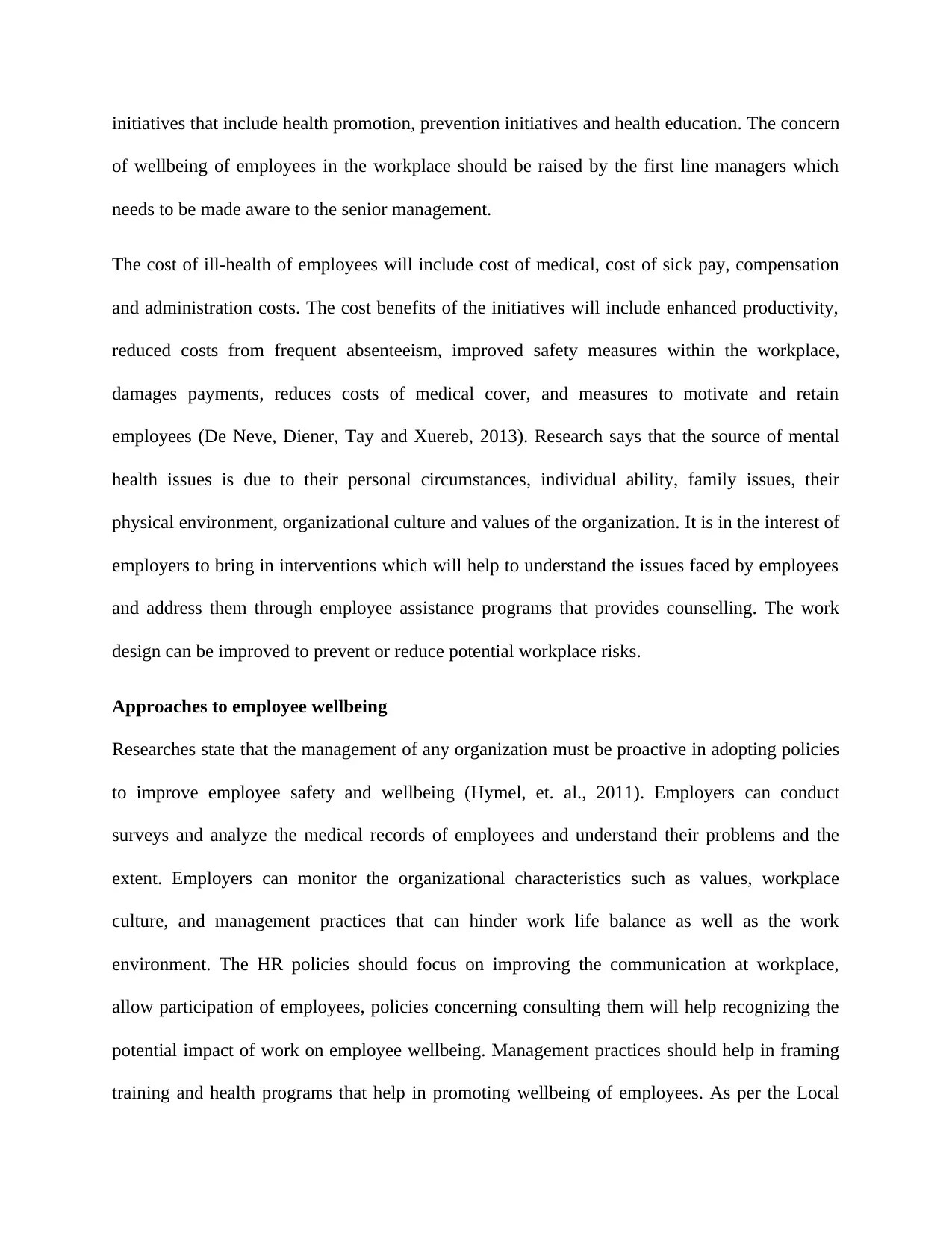
initiatives that include health promotion, prevention initiatives and health education. The concern
of wellbeing of employees in the workplace should be raised by the first line managers which
needs to be made aware to the senior management.
The cost of ill-health of employees will include cost of medical, cost of sick pay, compensation
and administration costs. The cost benefits of the initiatives will include enhanced productivity,
reduced costs from frequent absenteeism, improved safety measures within the workplace,
damages payments, reduces costs of medical cover, and measures to motivate and retain
employees (De Neve, Diener, Tay and Xuereb, 2013). Research says that the source of mental
health issues is due to their personal circumstances, individual ability, family issues, their
physical environment, organizational culture and values of the organization. It is in the interest of
employers to bring in interventions which will help to understand the issues faced by employees
and address them through employee assistance programs that provides counselling. The work
design can be improved to prevent or reduce potential workplace risks.
Approaches to employee wellbeing
Researches state that the management of any organization must be proactive in adopting policies
to improve employee safety and wellbeing (Hymel, et. al., 2011). Employers can conduct
surveys and analyze the medical records of employees and understand their problems and the
extent. Employers can monitor the organizational characteristics such as values, workplace
culture, and management practices that can hinder work life balance as well as the work
environment. The HR policies should focus on improving the communication at workplace,
allow participation of employees, policies concerning consulting them will help recognizing the
potential impact of work on employee wellbeing. Management practices should help in framing
training and health programs that help in promoting wellbeing of employees. As per the Local
of wellbeing of employees in the workplace should be raised by the first line managers which
needs to be made aware to the senior management.
The cost of ill-health of employees will include cost of medical, cost of sick pay, compensation
and administration costs. The cost benefits of the initiatives will include enhanced productivity,
reduced costs from frequent absenteeism, improved safety measures within the workplace,
damages payments, reduces costs of medical cover, and measures to motivate and retain
employees (De Neve, Diener, Tay and Xuereb, 2013). Research says that the source of mental
health issues is due to their personal circumstances, individual ability, family issues, their
physical environment, organizational culture and values of the organization. It is in the interest of
employers to bring in interventions which will help to understand the issues faced by employees
and address them through employee assistance programs that provides counselling. The work
design can be improved to prevent or reduce potential workplace risks.
Approaches to employee wellbeing
Researches state that the management of any organization must be proactive in adopting policies
to improve employee safety and wellbeing (Hymel, et. al., 2011). Employers can conduct
surveys and analyze the medical records of employees and understand their problems and the
extent. Employers can monitor the organizational characteristics such as values, workplace
culture, and management practices that can hinder work life balance as well as the work
environment. The HR policies should focus on improving the communication at workplace,
allow participation of employees, policies concerning consulting them will help recognizing the
potential impact of work on employee wellbeing. Management practices should help in framing
training and health programs that help in promoting wellbeing of employees. As per the Local
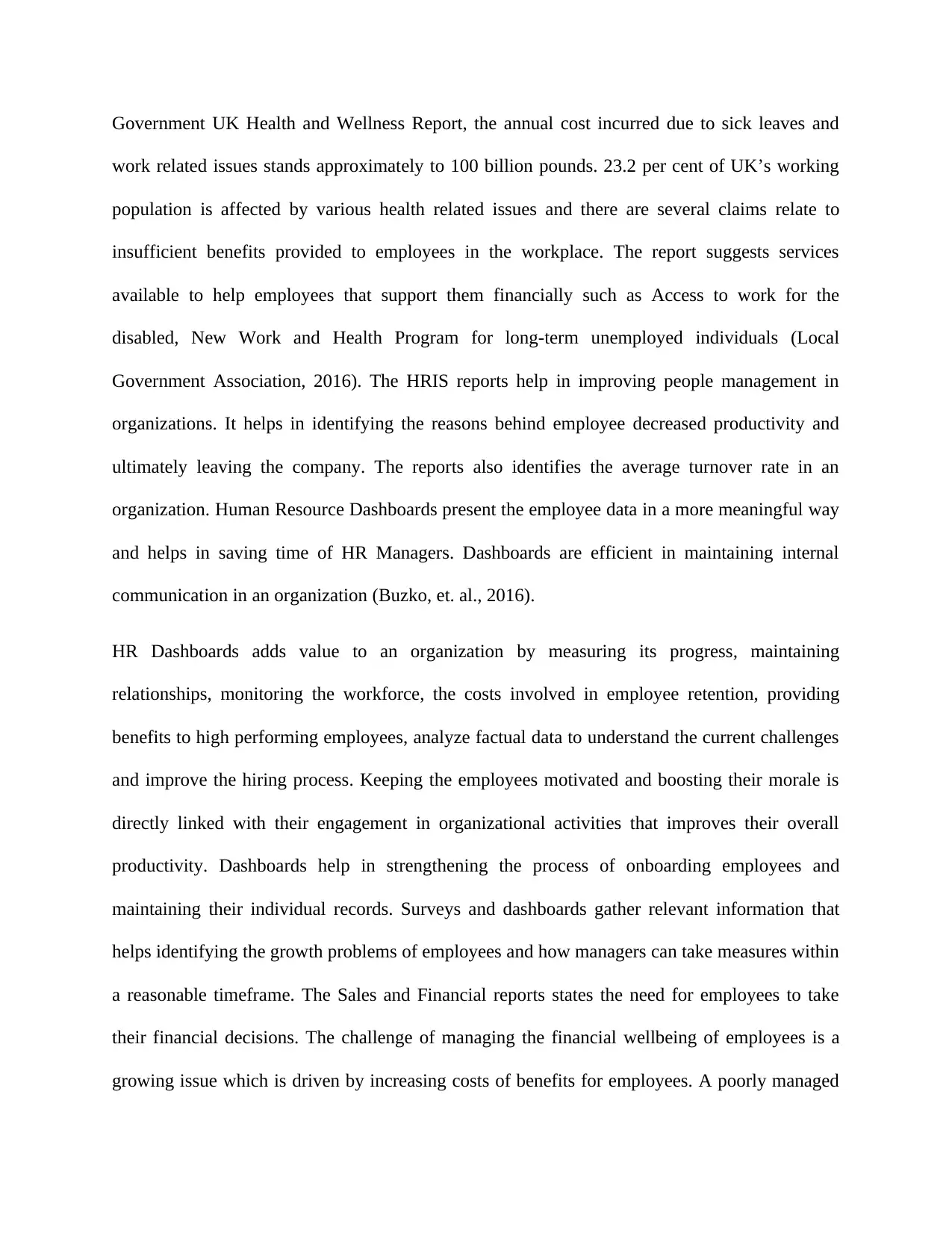
Government UK Health and Wellness Report, the annual cost incurred due to sick leaves and
work related issues stands approximately to 100 billion pounds. 23.2 per cent of UK’s working
population is affected by various health related issues and there are several claims relate to
insufficient benefits provided to employees in the workplace. The report suggests services
available to help employees that support them financially such as Access to work for the
disabled, New Work and Health Program for long-term unemployed individuals (Local
Government Association, 2016). The HRIS reports help in improving people management in
organizations. It helps in identifying the reasons behind employee decreased productivity and
ultimately leaving the company. The reports also identifies the average turnover rate in an
organization. Human Resource Dashboards present the employee data in a more meaningful way
and helps in saving time of HR Managers. Dashboards are efficient in maintaining internal
communication in an organization (Buzko, et. al., 2016).
HR Dashboards adds value to an organization by measuring its progress, maintaining
relationships, monitoring the workforce, the costs involved in employee retention, providing
benefits to high performing employees, analyze factual data to understand the current challenges
and improve the hiring process. Keeping the employees motivated and boosting their morale is
directly linked with their engagement in organizational activities that improves their overall
productivity. Dashboards help in strengthening the process of onboarding employees and
maintaining their individual records. Surveys and dashboards gather relevant information that
helps identifying the growth problems of employees and how managers can take measures within
a reasonable timeframe. The Sales and Financial reports states the need for employees to take
their financial decisions. The challenge of managing the financial wellbeing of employees is a
growing issue which is driven by increasing costs of benefits for employees. A poorly managed
work related issues stands approximately to 100 billion pounds. 23.2 per cent of UK’s working
population is affected by various health related issues and there are several claims relate to
insufficient benefits provided to employees in the workplace. The report suggests services
available to help employees that support them financially such as Access to work for the
disabled, New Work and Health Program for long-term unemployed individuals (Local
Government Association, 2016). The HRIS reports help in improving people management in
organizations. It helps in identifying the reasons behind employee decreased productivity and
ultimately leaving the company. The reports also identifies the average turnover rate in an
organization. Human Resource Dashboards present the employee data in a more meaningful way
and helps in saving time of HR Managers. Dashboards are efficient in maintaining internal
communication in an organization (Buzko, et. al., 2016).
HR Dashboards adds value to an organization by measuring its progress, maintaining
relationships, monitoring the workforce, the costs involved in employee retention, providing
benefits to high performing employees, analyze factual data to understand the current challenges
and improve the hiring process. Keeping the employees motivated and boosting their morale is
directly linked with their engagement in organizational activities that improves their overall
productivity. Dashboards help in strengthening the process of onboarding employees and
maintaining their individual records. Surveys and dashboards gather relevant information that
helps identifying the growth problems of employees and how managers can take measures within
a reasonable timeframe. The Sales and Financial reports states the need for employees to take
their financial decisions. The challenge of managing the financial wellbeing of employees is a
growing issue which is driven by increasing costs of benefits for employees. A poorly managed
⊘ This is a preview!⊘
Do you want full access?
Subscribe today to unlock all pages.

Trusted by 1+ million students worldwide
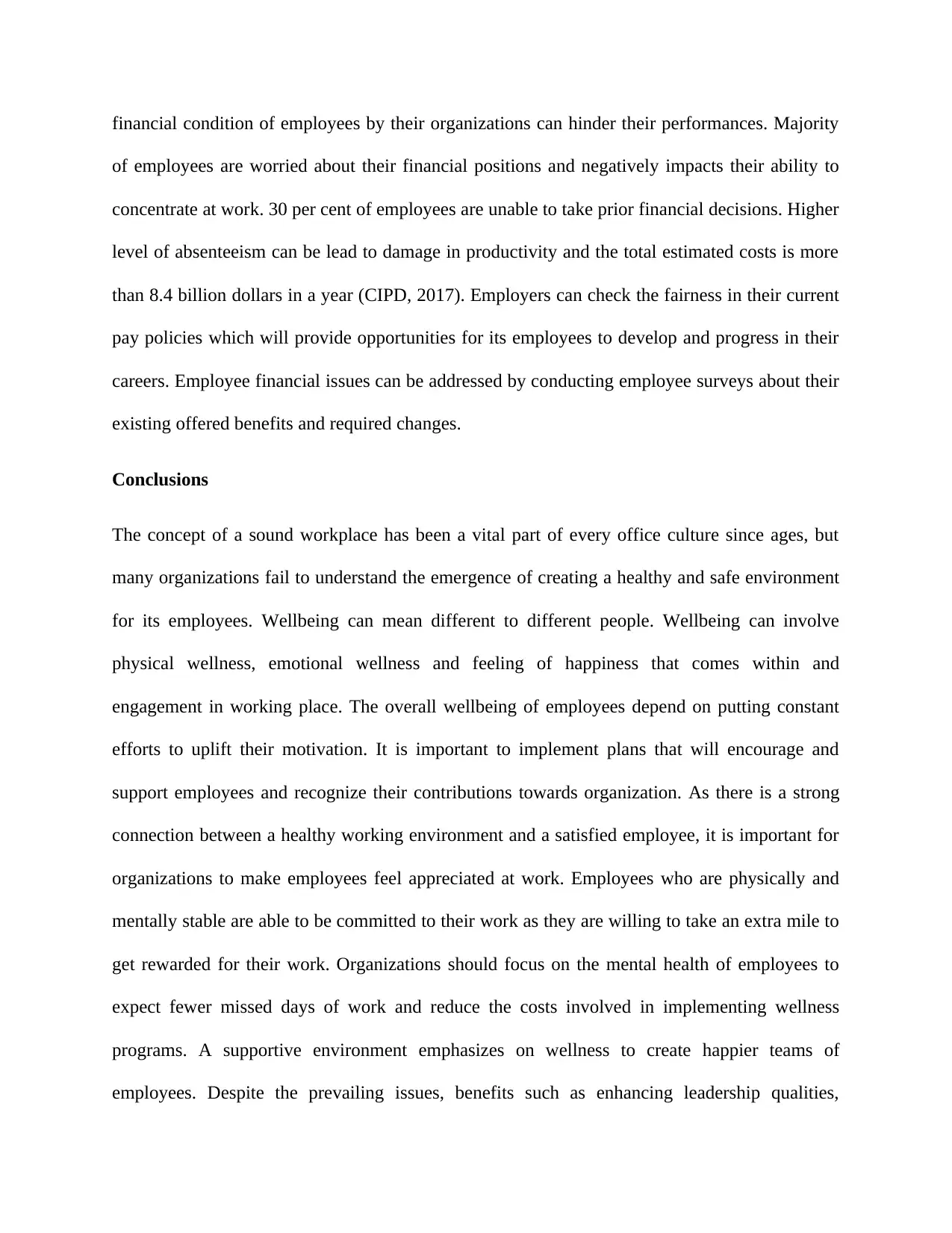
financial condition of employees by their organizations can hinder their performances. Majority
of employees are worried about their financial positions and negatively impacts their ability to
concentrate at work. 30 per cent of employees are unable to take prior financial decisions. Higher
level of absenteeism can be lead to damage in productivity and the total estimated costs is more
than 8.4 billion dollars in a year (CIPD, 2017). Employers can check the fairness in their current
pay policies which will provide opportunities for its employees to develop and progress in their
careers. Employee financial issues can be addressed by conducting employee surveys about their
existing offered benefits and required changes.
Conclusions
The concept of a sound workplace has been a vital part of every office culture since ages, but
many organizations fail to understand the emergence of creating a healthy and safe environment
for its employees. Wellbeing can mean different to different people. Wellbeing can involve
physical wellness, emotional wellness and feeling of happiness that comes within and
engagement in working place. The overall wellbeing of employees depend on putting constant
efforts to uplift their motivation. It is important to implement plans that will encourage and
support employees and recognize their contributions towards organization. As there is a strong
connection between a healthy working environment and a satisfied employee, it is important for
organizations to make employees feel appreciated at work. Employees who are physically and
mentally stable are able to be committed to their work as they are willing to take an extra mile to
get rewarded for their work. Organizations should focus on the mental health of employees to
expect fewer missed days of work and reduce the costs involved in implementing wellness
programs. A supportive environment emphasizes on wellness to create happier teams of
employees. Despite the prevailing issues, benefits such as enhancing leadership qualities,
of employees are worried about their financial positions and negatively impacts their ability to
concentrate at work. 30 per cent of employees are unable to take prior financial decisions. Higher
level of absenteeism can be lead to damage in productivity and the total estimated costs is more
than 8.4 billion dollars in a year (CIPD, 2017). Employers can check the fairness in their current
pay policies which will provide opportunities for its employees to develop and progress in their
careers. Employee financial issues can be addressed by conducting employee surveys about their
existing offered benefits and required changes.
Conclusions
The concept of a sound workplace has been a vital part of every office culture since ages, but
many organizations fail to understand the emergence of creating a healthy and safe environment
for its employees. Wellbeing can mean different to different people. Wellbeing can involve
physical wellness, emotional wellness and feeling of happiness that comes within and
engagement in working place. The overall wellbeing of employees depend on putting constant
efforts to uplift their motivation. It is important to implement plans that will encourage and
support employees and recognize their contributions towards organization. As there is a strong
connection between a healthy working environment and a satisfied employee, it is important for
organizations to make employees feel appreciated at work. Employees who are physically and
mentally stable are able to be committed to their work as they are willing to take an extra mile to
get rewarded for their work. Organizations should focus on the mental health of employees to
expect fewer missed days of work and reduce the costs involved in implementing wellness
programs. A supportive environment emphasizes on wellness to create happier teams of
employees. Despite the prevailing issues, benefits such as enhancing leadership qualities,
Paraphrase This Document
Need a fresh take? Get an instant paraphrase of this document with our AI Paraphraser
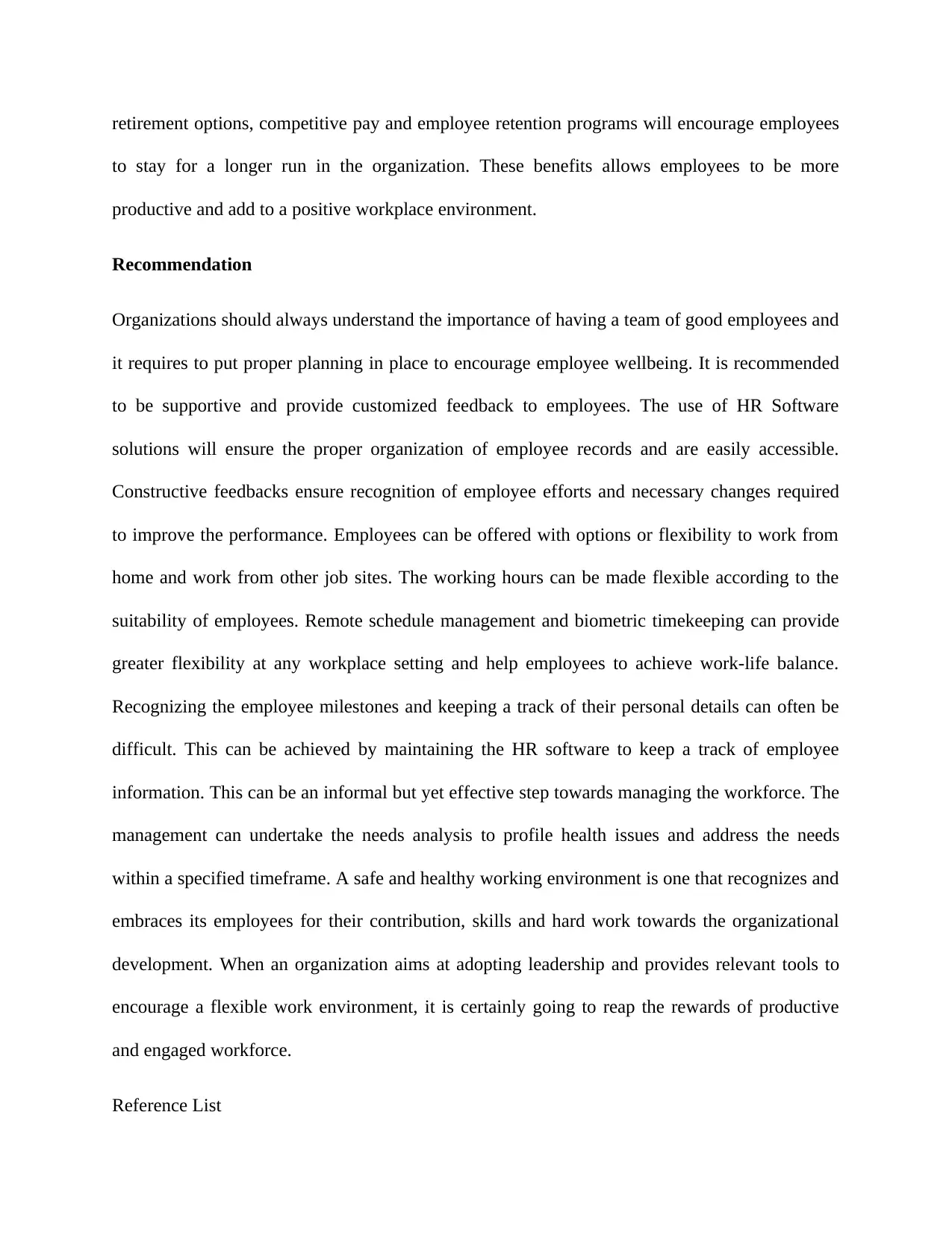
retirement options, competitive pay and employee retention programs will encourage employees
to stay for a longer run in the organization. These benefits allows employees to be more
productive and add to a positive workplace environment.
Recommendation
Organizations should always understand the importance of having a team of good employees and
it requires to put proper planning in place to encourage employee wellbeing. It is recommended
to be supportive and provide customized feedback to employees. The use of HR Software
solutions will ensure the proper organization of employee records and are easily accessible.
Constructive feedbacks ensure recognition of employee efforts and necessary changes required
to improve the performance. Employees can be offered with options or flexibility to work from
home and work from other job sites. The working hours can be made flexible according to the
suitability of employees. Remote schedule management and biometric timekeeping can provide
greater flexibility at any workplace setting and help employees to achieve work-life balance.
Recognizing the employee milestones and keeping a track of their personal details can often be
difficult. This can be achieved by maintaining the HR software to keep a track of employee
information. This can be an informal but yet effective step towards managing the workforce. The
management can undertake the needs analysis to profile health issues and address the needs
within a specified timeframe. A safe and healthy working environment is one that recognizes and
embraces its employees for their contribution, skills and hard work towards the organizational
development. When an organization aims at adopting leadership and provides relevant tools to
encourage a flexible work environment, it is certainly going to reap the rewards of productive
and engaged workforce.
Reference List
to stay for a longer run in the organization. These benefits allows employees to be more
productive and add to a positive workplace environment.
Recommendation
Organizations should always understand the importance of having a team of good employees and
it requires to put proper planning in place to encourage employee wellbeing. It is recommended
to be supportive and provide customized feedback to employees. The use of HR Software
solutions will ensure the proper organization of employee records and are easily accessible.
Constructive feedbacks ensure recognition of employee efforts and necessary changes required
to improve the performance. Employees can be offered with options or flexibility to work from
home and work from other job sites. The working hours can be made flexible according to the
suitability of employees. Remote schedule management and biometric timekeeping can provide
greater flexibility at any workplace setting and help employees to achieve work-life balance.
Recognizing the employee milestones and keeping a track of their personal details can often be
difficult. This can be achieved by maintaining the HR software to keep a track of employee
information. This can be an informal but yet effective step towards managing the workforce. The
management can undertake the needs analysis to profile health issues and address the needs
within a specified timeframe. A safe and healthy working environment is one that recognizes and
embraces its employees for their contribution, skills and hard work towards the organizational
development. When an organization aims at adopting leadership and provides relevant tools to
encourage a flexible work environment, it is certainly going to reap the rewards of productive
and engaged workforce.
Reference List
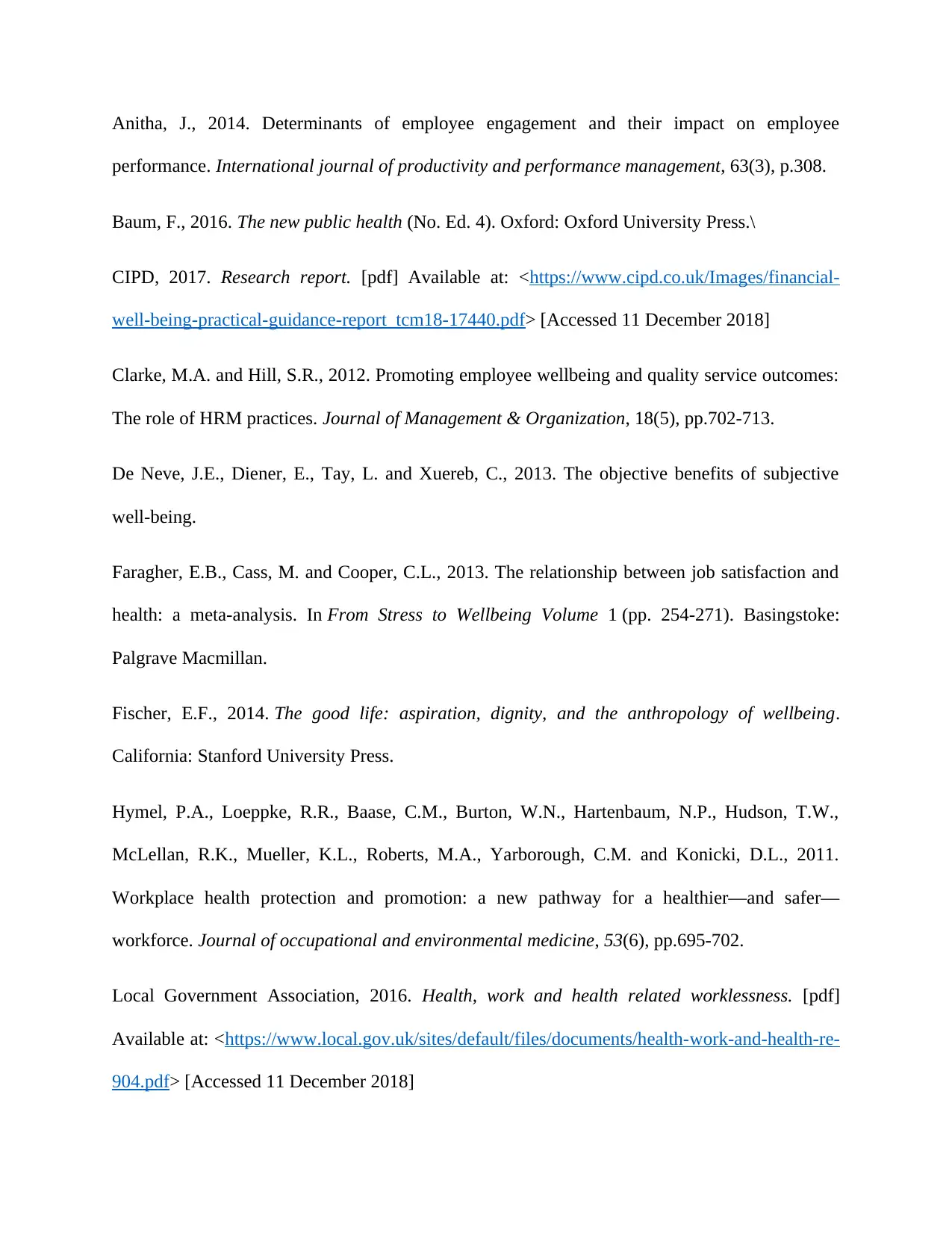
Anitha, J., 2014. Determinants of employee engagement and their impact on employee
performance. International journal of productivity and performance management, 63(3), p.308.
Baum, F., 2016. The new public health (No. Ed. 4). Oxford: Oxford University Press.\
CIPD, 2017. Research report. [pdf] Available at: <https://www.cipd.co.uk/Images/financial-
well-being-practical-guidance-report_tcm18-17440.pdf> [Accessed 11 December 2018]
Clarke, M.A. and Hill, S.R., 2012. Promoting employee wellbeing and quality service outcomes:
The role of HRM practices. Journal of Management & Organization, 18(5), pp.702-713.
De Neve, J.E., Diener, E., Tay, L. and Xuereb, C., 2013. The objective benefits of subjective
well-being.
Faragher, E.B., Cass, M. and Cooper, C.L., 2013. The relationship between job satisfaction and
health: a meta-analysis. In From Stress to Wellbeing Volume 1 (pp. 254-271). Basingstoke:
Palgrave Macmillan.
Fischer, E.F., 2014. The good life: aspiration, dignity, and the anthropology of wellbeing.
California: Stanford University Press.
Hymel, P.A., Loeppke, R.R., Baase, C.M., Burton, W.N., Hartenbaum, N.P., Hudson, T.W.,
McLellan, R.K., Mueller, K.L., Roberts, M.A., Yarborough, C.M. and Konicki, D.L., 2011.
Workplace health protection and promotion: a new pathway for a healthier—and safer—
workforce. Journal of occupational and environmental medicine, 53(6), pp.695-702.
Local Government Association, 2016. Health, work and health related worklessness. [pdf]
Available at: <https://www.local.gov.uk/sites/default/files/documents/health-work-and-health-re-
904.pdf> [Accessed 11 December 2018]
performance. International journal of productivity and performance management, 63(3), p.308.
Baum, F., 2016. The new public health (No. Ed. 4). Oxford: Oxford University Press.\
CIPD, 2017. Research report. [pdf] Available at: <https://www.cipd.co.uk/Images/financial-
well-being-practical-guidance-report_tcm18-17440.pdf> [Accessed 11 December 2018]
Clarke, M.A. and Hill, S.R., 2012. Promoting employee wellbeing and quality service outcomes:
The role of HRM practices. Journal of Management & Organization, 18(5), pp.702-713.
De Neve, J.E., Diener, E., Tay, L. and Xuereb, C., 2013. The objective benefits of subjective
well-being.
Faragher, E.B., Cass, M. and Cooper, C.L., 2013. The relationship between job satisfaction and
health: a meta-analysis. In From Stress to Wellbeing Volume 1 (pp. 254-271). Basingstoke:
Palgrave Macmillan.
Fischer, E.F., 2014. The good life: aspiration, dignity, and the anthropology of wellbeing.
California: Stanford University Press.
Hymel, P.A., Loeppke, R.R., Baase, C.M., Burton, W.N., Hartenbaum, N.P., Hudson, T.W.,
McLellan, R.K., Mueller, K.L., Roberts, M.A., Yarborough, C.M. and Konicki, D.L., 2011.
Workplace health protection and promotion: a new pathway for a healthier—and safer—
workforce. Journal of occupational and environmental medicine, 53(6), pp.695-702.
Local Government Association, 2016. Health, work and health related worklessness. [pdf]
Available at: <https://www.local.gov.uk/sites/default/files/documents/health-work-and-health-re-
904.pdf> [Accessed 11 December 2018]
⊘ This is a preview!⊘
Do you want full access?
Subscribe today to unlock all pages.

Trusted by 1+ million students worldwide

Mowday, R.T., Porter, L.W. and Steers, R.M., 2013. Employee—organization linkages: The
psychology of commitment, absenteeism, and turnover. Cambridge: Academic press.
O’neill, J.W. and Davis, K., 2011. Work stress and well-being in the hotel
industry. International journal of hospitality management, 30(2), pp.385-390.
psychology of commitment, absenteeism, and turnover. Cambridge: Academic press.
O’neill, J.W. and Davis, K., 2011. Work stress and well-being in the hotel
industry. International journal of hospitality management, 30(2), pp.385-390.
1 out of 10
Related Documents
Your All-in-One AI-Powered Toolkit for Academic Success.
+13062052269
info@desklib.com
Available 24*7 on WhatsApp / Email
![[object Object]](/_next/static/media/star-bottom.7253800d.svg)
Unlock your academic potential
Copyright © 2020–2026 A2Z Services. All Rights Reserved. Developed and managed by ZUCOL.




